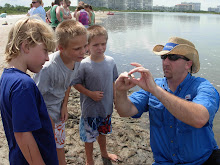 |
| Don't let this happen to your boat!! |
Tomorrow marks the beginning of what experts from NOAA's Climate Prediction Center predict to be an above-average hurricane season for 2011.
- 12 to 18 named storms (winds of 39 mph or higher), of which:
- 6 to 10 could become hurricanes (winds of 74 mph or higher), including:
- 3 to 6 major hurricanes (Category 3, 4 or 5; winds of 111 mph or higher)
Although it has been several years since a major storm has hit Florida's coast, Floridians should not take for granted this lull and be prepared if a storm does hit. In general, now is the time, if you don't already have one, to put together a plan for you and your family. To learn more about preparing a hurricane plan visit: ready.gov
Boaters, in particular, need to make sure they know how to secure their boat in case a hurricane approaches. Not doing so can result in the loss of your property, potential injury or death, and even unnecessary environmental destruction. The key to protecting your boat from hurricanes or any threatening severe weather is planning, preparation and timely action.
GENERAL PRECAUTIONS
- Prior to the hurricane season, develop a detailed plan of action to secure your vessel in the marina, if permitted, to remove your boat from the threatened area, or to take your boat to a previously identified hurricane refuge. Specifically identify and assemble needed equipment and supplies.
- Hurricane moorings should be located in advance. Permission should be obtained from appropriate persons. For keel boats, make certain there is enough water at low tide.
- A practice run should be made to check accessibility, depth of water, bridges, location of aids and/or obstructions to navigation and locations to secure lines or drop anchors. According to a Florida statute beginning in 1993, drawbridges will not open for boats during evacuation procedures.
- Before a hurricane threatens, plan how you will remove valuable equipment from the boat. Determine how long it will take so you will have an accurate estimate of the time and work involved. After you have made anchoring or mooring provisions, remove all movable equipment such as canvas, sails, dinghies, radios, cushions, biminis and roller furling sails. Lash down everything you cannot remove, such as tillers, wheels, booms, etc. Seal all openings (use duct tape) to make the boat as watertight as possible. Make sure the electrical system is off unless you plan to leave the boat in the water. If the boat is not to remain in the water, remove the battery to eliminate the risk of fire or other damage.
- Arrange for a reliable person to learn and carry out your hurricane plan if you are out of town during a hurricane or severe storm. Check your lease or rental agreement with the marina or storage area. Know your responsibilities and liabilities as well as those of the marina or storage area.
- Consolidate all documents including insurance policies, a recent photograph or video tape of your vessel, boat registration, equipment inventory, lease agreement with the marina or storage area, and telephone numbers of appropriate authorities, such as the harbor master, Coast Guard, insurance agent, National Weather Service, etc.
- Keep the documents in your possession in a locked water-proof box. They may be needed when you return to check on your boat after the hurricane.
- Maintain an inventory list of both the items removed and those left on board. Items of value should be marked so that they can be readily identified.
To learn more about preparing your boat for hurricane season visit:





No comments:
Post a Comment